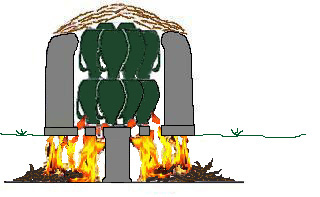 |
Ashmolean Museum of Art and Archaeology | The Collections: | ||
| PotWeb: | Ceramics
online @ the Ashmolean Museum |
• | Early Europe & Near East | |
| • | Classical to Medieval | |||
| • | Europe from 1500 | |||
| • | Oriental & Islamic | |||
| Fingerprints of the maker |
| How were pots fired? | |
|
Medieval forms and clay types were less standardised than nineteenth-century
industrialised production. Fired clay vessels have a range of colours,
depending on mineral inclusions and the firing temperature. Sap in the
brushwood or tree loppings, at different seasons, affected the final colour
of the fired clay and the colour of the glaze. Such variations were frequently
unintended, but some wares show a consistency that suggests an impressive
level of control by the potter.
Much pottery was fired in a bonfire or pit with no permanent super-structure. The pots were generally fired upside down. A later development was the `ring-wall' kiln type where the fuel and the wares share the space within the wall and are covered with waste sherds or clay during firing. A further development was the updraught kiln, in which the fuel was confined in a fire-pit, the wares being supported above it on a perforated floor. This type of kiln was fed by single, double or multiple flues. |
|
| Martyn Jope excavated the site of a medieval pottery kiln at Brill, during the summer of 1953, on behalf of the Ashmolean Museum. The kiln was fired from both sides (double flues), a fire being lit at each end. This was the first time such a kiln type had been recognised. The pots were stacked on the firing platform and were probably covered by a clamp of brushwood and clay. This kiln dated to the fourteenth century, but was built on top of at least two others dating to the second half of the thirteenth century. Great quantities of wasters, including many almost complete pots, both glazed and unglazed were recovered (see `The making of the vessel'). | 
Cross-sectional diagram showing the flames and hot gases of the double flue kiln drawn up on to the firing platform |
| The site was discovered through the presence of pottery wasters and areas of black, ash-rich soil. | |
| Decorative techniques | Fingerprints ... | Smart potters succeed |
|
© Copyright University of Oxford, Ashmolean Museum, 2000 The Ashmolean Museum retains the copyright of all materials used here and in its Museum Web pages. last updated: jcm/27-jun-2000 |